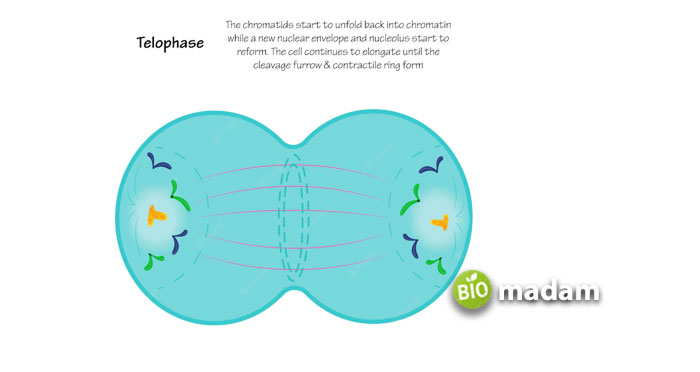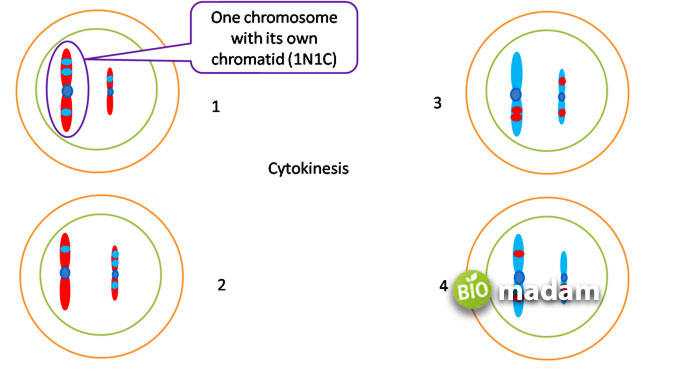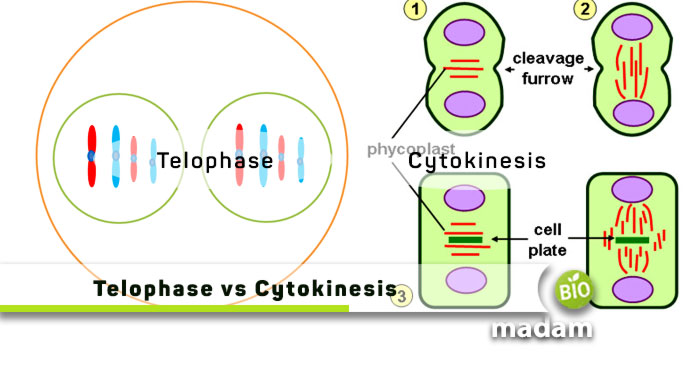All living organisms go through replication and division processes like mitosis and meiosis. Mitosis is responsible for cell generation and regeneration for body growth and development. Alternatively, mitosis facilitates sexual reproduction to ensure the transfer of genes and alleles properly. Both these processes are quite similar to each other, including phases like telophase and cytokinesis. However, they differ slightly in each process of cell division and multiplication.
Let’s tell you the differences between telophase and cytokinesis.
Comparison Table
| Factors | Telophase | Cytokinesis |
| Definition | Last stage of the M phase | End of cell division |
| Occurrence | After anaphase | After telophase |
| Mechanism | Two daughter nuclear membranes develop | Cleavage furrow or cell plate forms |
| End Product | Two daughter nuclei | Two daughter cells |
| Significance | Division of genetic material | Nuclei, cytoplasm, and cell organelle division |
What is Telophase?
The final stage of nuclear division, following anaphase, is telophase. The term “telophase” refers to the previous phase of meiosis and mitosis in different eukaryotic cells. Eventually, it is the last stage of karyokinesis. The nucleolus and nuclear membrane disintegrate during prophase, and prometaphase reverses during telophase. The nuclear envelope rebuilds around the new nuclei during telophase. When the cell has stopped shifting the chromosomes, the significant components of the spindle mechanism depolymerize or break down. The chromosomes dissociate into chromatin, from its firmly bonded structure as telophase is near to completion.

Steps of Telophase
- Decondensation of chromosomes
- Surrounding of nuclear envelop around the chromosomes
- The disintegration of spindle fibers
Telophase in Mitosis
Anaphase usually causes daughter chromosomes to separate during mitosis and move to the cell’s opposite poles at the equatorial plate. It results from the tension created by the spindle mechanism. Two daughter nuclei are produced during telophase. The nuclear envelope starts to surface once more. Spindle microtubules form to depolymerize when DNA begins to decondense. The division of one nucleus into two during mitosis is now finished.
Telophase in Meiosis
Two divisions make up meiosis (reduction division), each with a telophase stage: Telophase in meiosis I and II. The homologous chromosomes split into distinct nuclei during telophase in meiosis I. The cells need to rebuild the nuclear envelopes, disintegrate the spindle fiber microtubules, and go through cytokinesis for meiosis to complete. The cells then go through a brief resting phase called interkinesis. It is possible sometimes to miss this stage since meiosis II is soon to commence. As a result of the subsequent cell division, the sister chromatids of each chromosome splits apart. New nuclear membranes envelop the sister chromosomes during telophase II.
However, the identical chromosome that undergoes replication, transcription, and translation processes gives rise to the two cells produced during telophase II, the recombination process—in which the switched pieces of homologous chromosomes can bring variation. The two alleles for each gene and alleles for numerous other genes may segregate in various ways among the four cells formed at the end of meiosis.
What is Cytokinesis?
Cytokinesis, a procedure that divides the cell into two new cells, terminates telophase. In biology, cytokinesis is the process through which a single cell physically divides into two. Cytokinesis refers to the “cytoplasmic division.” The cytoplasmic division occurs after the first division of the cell, known as karyokinesis, in which the nucleus splits in two. Each daughter cell inherits the mother cell’s whole cytoplasm and cell organelles. Karyokinesis is a necessary component of the process.
Cytokinesis is the primary method of reproduction for unicellular organisms. It also occurs during the growth and repair of tissues in higher or vascular plants and animals and embryo development. It often happens after nuclear doubling in mitosis and meiosis. However, occasionally it could happen before the telophase, or it might not happen at all. Multinucleated cells are the result of the lack of cytokinesis.
Prokaryotes mainly reproduce through binary fission and budding, which is a method of asexual reproduction. The mother cell grows until it physically splits into two identical daughter cells by cytokinesis. Cytokinesis is comparable to the prokaryotic process of binary fission, but the two methods are different because of variations in the forms and functions of bacterial and eukaryotic cells.

Steps of Cytokinesis
- Initiation
- Contraction
- Membrane insertion
- Completion
Cytokinesis in Mitosis
The M phase, which includes mitosis and cytokinesis, is the last phase of the eukaryotic cell cycle. Anaphase marks the beginning of cytokinesis, which ends in telophase, just before the next interphase. All these actions occur during the mitosis of an animal or plant cell. Animal and plant cells differ slightly in cytokinesis.
Animal Cells: A cleavage furrow is responsible for the division of daughter cells.
Plant Cells: A cell plate is responsible for dividing daughter cells.
Cytokinesis in Meiosis
When the cell pinches in half to produce two daughter cells after the homologous pairs move to the opposite ends, each daughter cell receives one haploid pair of chromosomes due to this first meiotic division (cytokinesis 1). During meiosis II, cytokinesis II involves the division of each haploid daughter cell. Usually, cytokinesis, which creates two haploid daughter cells, coincides with telophase I.
Similarities between Telophase and Cytokinesis
- Telophase and cytokinesis are cell division phases leading to the formation of daughter cells.
- They occur during meiosis and mitosis.
- They are also in charge of splitting specific cell components into two.
Differences between Telophase and Cytokinesis
Definition
Telophase
It is the last stage of the M phase of the cell cycle and nuclear division.
Cytokinesis
Cytokinesis marks the end of cell division that begins after telophase.
Occurrence
Telophase
Telophase takes place after anaphase.
Cytokinesis
Whereas cytokinesis occurs after telophase.
Mechanism
Telophase
Telophase occurs when two daughter nuclear membranes develop, producing chromatin. It is the phase during which the nuclear envelop and nucleoli form.
Cytokinesis
In contrast, a cleavage furrow in animal cells and a cell plate in plant cells develop during cytokinesis. This process involves the division of cytosol or cytoplasm.
End Products
Telophase
Telophase produces two daughter nuclei.
Cytokinesis
At the same time, cytokinesis produces two distinct daughter cells.
Significance
Telophase
Telophase involves only the division of genetic material, like DNA and chromosomes.
Cytokinesis
While cytokinesis involves even division of the two nuclei, cytoplasm, and cell organelles, for e.g., mitochondria and chloroplast.
The Bottom Line
Telophase and cytokinesis are part of mitosis and meiosis, leading to the formation of daughter cells. Telophase occurs after anaphase, and cytokinesis follows telophase. The main difference between telophase and cytokinesis is the division of nuclei and distinct daughter cells in both, respectively. Cytokinesis in mitosis and meiosis contributes to the division of cytoplasm within the cell to give rise to equally distributed cells.

Jeannie has achieved her Master’s degree in science and technology and is further pursuing a Ph.D. She desires to provide you the validated knowledge about science, technology, and the environment through writing articles.

